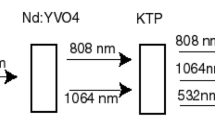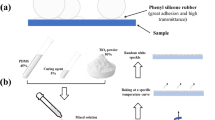Abstract
An investigation of the inhomogeneous and anisotropic properties of myocardium necessitates a whole field measurement technique with high spatial resolution. Computer aided speckle interferometry (CASI) may be applied to measuring deformation on the epicardial surface of the heart. Silicone carbide particles (approximately 40 μm in diameter) were sprinkled randomly onto the epicardial surface of isolated rabbit hearts. When illuminated with white light, speckles may be observed with a charge coupled device (CCD) camera. A balloon was placed in the left ventricle to control the intracavitary load on the arrested heart. To compare CASI to the “gold” standard technique of sonomicrometry, two ultrasonic transducers were implanted into the wall of the myocardium. Three hearts were exposed to various loading conditions, and at each condition speckle images were recorded. CASI was used to determine the distribution of displacement vectors (both direction and magnitude) in the region imaged by the CCD camera. Strain along the axis of the implanted transducers was determined with CASI and compared to that obtained with sonomicrometry. Strain determined from CASI and sonomicrometry produced equivalent results. Unlike sonomicrometry, whereby the displacement between two points with a relatively large gauge length is obtained, CASI is able to determine displacement vectors for hundreds of “points” within the same region. In conclusion, CASI produced equivalent results to those obtained from sonomicrometry (although not with the same temporal resolution), but it is a whole field deformation mapping technique that has a spatial resolution three orders of magnitude higher than that of sonomicrometry. © 2001 Biomedical Engineering Society.
PAC01: 8763Lk, 8719Hh, 8719Rr
Similar content being viewed by others
References
Asundi, A., and F. P. Chiang. Theory and application of white light speckle methods. Opt. Eng.24:570–580, 1982.
Burns, P. G., I. B. Krukenkamp, and C. A. Caldarone. Does cardiopulmonary bypass alone elicit myoprotective preconditioning?Circulation92:447–451, 1995.
Chen, D. J. Computer aided speckle interferometry (CASI) and its application to strain analysis. PhD dissertation, Department of Mechanical Engineering, SUNY-Stony Brook, 1993.
Chen, D. J., and F. P. Chiang. Optimal sampling resolution and range of measurement in digital speckle correlation 2: White speckle method. Proceeding of SEM Annual Spring Conference on Exp Mechanics, 1989.
Chen, D. J., and F. P. Chiang. Range of measurement of computer aided speckle interferometery (CASI). Proceeding of the Second International Conference on Photomechanics and Speckle Metrology. 1554A, 1991.
Chen, D. J., F. P. Chiang, Y. S. Tan, and H. S. Don. Digital speckle-displacement measurements using a complex spectrum method. Appl. Opt.32:1839–1849, 1993.
Chiang, F. P.A family of 2D and 3D experimental stress analysis technique using laser speckles. Solid Mech. Arch.30:1–32, 1978.
Chiang, F. P. Speckle Metrology. Metals Handbook, Vol. 17 SSM-International, 1989, pp. 432–437.
Chiang, F. P., Q. Wang, and F. Lehman. New development's in full field strain measurements using speckles. In: Nontraditional Methods of Sensing Stress, Strains, and Damage in Materials and Structures, edited by C. F. Lucas and D. A. Stubbs. ASTM, 1997, pp. 156–169.
Erf, R. K. Speckle Metrology. New York: Academic Press, 1978.
Fan, D., L. K. Soei, and R. Stubenitsky. Contribution of asynchrony and nonuniformity to mechanical interaction in normal and stunned myocardium. Am. J. Physiol.273:H2146–H2154, 1997.
Fu, D., S. F. Levinson, S. M. Gracewski, and K. J. Parker. Noninvasive quantitative reconstruction of tissue elasticity using an iterative forward approach. Phys. Med. Biol.45:1495–1509, 2000.
Fukuoka, S., T. Hotokebuchi, and S. Jingushi. Evaluation of blood flow within the subchondral bone of the femoral head: Use of the laser speckle method at surgery for osteonecrosis. J. Orthop. Res.17:80–87, 1999.
Fung, Y. C. Biomechanics, Mechanical Properties of Living Tissues. New York: Springer, 1981.
Hunziker, P. R., S. Smith, and M. Scherrer-Crosbie. Dynamic holographic imaging of the beating human heart. Circulation99(e3):1–6, 1999.
Kang, T., and R. C. P. Yin. The need to account for residual strains and composite nature of heart wall in mechanical analyses. Am. J. Physiol.271:H947–H961, 1996.
Keating, T. J., and G. G. Borisy. Speckle microscopy: When less is more. Curr. Biol.10:R22–R24, 2000.
Kirkpatrick, S. J., and M. J. Cipolla. High resolution imaged laser speckle strain gauge for vascular applications. J. Biomed. Opt.5:62–71, 2000.
Li, D. W., and F. P. Chiang. Statistical analysis of one-beam subjective laser speckle interfermotery for displacement and strain analysis. J. Opt. Soc. Am.2:657–666, 1985.
Li, D. W., and F. P. Chiang. Decorrelation function in speckle photography. J. Opt. Soc. Am.3:1023–1031, 1986.
Lu, H., G. Vendroux, and W. G. Knauss. Surface deformation measurements of a cylindrical specimen by digital image correlation. Exp. Mech.37:433–439, 1997.
Meunier, J.Tissue motion assessment from 3D echographic speckle tracking. Phys. Med. Biol.43:1241–1254, 1998.
Omens, J. H., D. D. Farr, A. D. McCulloch, and L. K. Waldman. Comparison of two techniques for measuring two-dimensional strain in rat left ventricles. Am. J. Physiol.271:H1256–H1261, 1996.
Peters, W. H., and W. F. Ranson. Digital imaging techniques in experimental stress analysis. Opt. Eng. (Bellingham)21:427–431, 1982.
Pinto, J. G., and Y. C. Fung. Mechanical properties of the stimulated papillary muscle in quick-release experiments. J. Biomech.6:617–630, 1973.
Prinzen, F. W., T. Arts, A. P. G. Hoeks, and R. S. Reneman. Discrepancies between myocardial blood flow and fiber shortening in the ischemic border zone as assessed with video mapping of epicardial deformation. Eur. J. Phys.415:220–229, 1989.
Roman, J. F., P. Fernandez, and V. Moreno. The mechanical behavior of human mandibles studied by electronic speckle pattern interferometry. Eur. J. Orthodon.21:413–421, 1999.
Vannan, M. A., Q. L. Cao, and N. G. Pandian. Volumetric multiplexed transmission holography of the heart with echocardiographic data. J. Am. Soc. Echocardiogr.8:567–575, 1995.
Villarreal, F. J., L. K. Waldman, and W. Y. W. Lew. Technique for measuring regional two-dimensional finite strains in canine left ventricle. Circ. Res.62:711–721, 1988.
Author information
Authors and Affiliations
Rights and permissions
About this article
Cite this article
Gaudette, G.R., Todaro, J., Krukenkamp, I.B. et al. Computer Aided Speckle Interferometry: A Technique for Measuring Deformation of the Surface of the Heart. Annals of Biomedical Engineering 29, 775–780 (2001). https://doi.org/10.1114/1.1397785
Issue Date:
DOI: https://doi.org/10.1114/1.1397785




